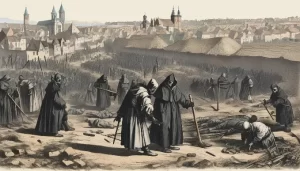The Black Death, a name synonymous with mass death and despair, was a catastrophic plague that swept across Europe and Asia during the mid-14th century. Between 1347 and 1351, this pandemic claimed the lives of an estimated 25 to 50 million people, making it one of the deadliest events in human history. Caused by the bacterium Yersinia pestis, the disease primarily spread through fleas on black rats, but humans were not spared once the Bubonic plague took hold. Medieval society was left utterly transformed by its horrifying toll.
1. How the Black Death Began
The origins of the Black Death trace back to the plains of Central Asia, where the plague bacterium first found a host in rodent populations. As these infected animals moved along trade routes, the disease spread swiftly across regions. It’s believed that Mongol armies, trade caravans, and merchant ships facilitated the transmission of the plague. By 1347, the disease had made its way to the Crimean Peninsula, where it took root in the city of Kaffa. Soon after, the Black Death arrived in Europe, forever altering its history.
2. Symptoms of the Plague
One of the most terrifying aspects of the Black Death was the gruesome symptoms that afflicted its victims. Those infected by the plague experienced fever, chills, vomiting, and most infamously, the development of “buboes” painful, swollen lymph nodes that turned black and burst. These symptoms gave the disease its moniker: the Bubonic Plague. Additionally, some suffered from septicaemic or pneumonic forms of the plague, which attacked the blood and lungs, respectively, and were even more fatal.
3. Spread of the Plague Through Trade Routes
The spread of the Black Death was greatly facilitated by the extensive trade networks of the medieval world. The Silk Road, the overland trade route connecting East and West, became a deadly path for the plague as it was carried by traders and their animals. Merchant ships also played a significant role in spreading the plague across the Mediterranean and into Europe’s busiest ports, such as Venice and Genoa. Once the disease reached Europe, it followed trade routes deep into the continent, leaving few areas untouched.
4. Death Toll of the Black Death
The death toll of the Black Death was nothing short of catastrophic. It’s estimated that the plague wiped out between one-third and half of Europe’s population. In some areas, entire villages were depopulated, and cities were left desolate. Countries like Italy, France, and England were particularly hard-hit. France saw the death of about half its population, while England lost around one-third. The global death toll, including parts of Asia and the Middle East, likely ranged from 75 to 200 million people.
5. Impact on Medieval Society and Economy
The Black Death didn’t just devastate populations it completely upended the social and economic order of the time. With so many deaths, labour became scarce, which increased the bargaining power of peasants and workers. The traditional feudal system began to crumble, as the landowners were forced to offer better wages to attract laborers. Additionally, the sheer scale of death led to a redistribution of wealth and land, leading to significant shifts in class structures.
6. The Role of Religion During the Black Death
Religion played a central role in how people interpreted and responded to the Black Death. Many believed the plague was divine punishment for human sin, and religious fervour reached fever pitch. Some towns organized religious processions, praying for deliverance from the plague. The flagellants, groups of devout individuals who whipped themselves in public as penance, became a common sight. Unfortunately, religious scapegoating also emerged, with Jewish communities being blamed for the spread of the disease, leading to widespread persecution.
7. Theories and Causes
In the absence of modern science, medieval societies grasped at explanations for the cause of the Black Death. Many turned to the miasma theory, which posited that “bad air” or noxious fumes caused disease. Others believed that the alignment of the planets or divine wrath explained the plague’s origins. These early theories, while incorrect, were deeply influential in shaping the ways societies reacted to the pandemic.
8. Medical Responses and Remedies
Medical knowledge in the 14th century was rudimentary, and most attempts to treat the Black Death were ineffective. Physicians recommended a variety of treatments, from bloodletting to the application of herbal concoctions. Some towns implemented quarantine measures, isolating infected individuals and limiting travel to curb the spread of the disease. However, most of these efforts proved futile in the face of such a virulent pathogen.
9. Long-term Consequences of the Black Death
The long-term effects of the Black Death were profound and far-reaching. In addition to the immediate devastation of populations and economies, the plague also contributed to significant social and political changes. The weakening of feudal structures, combined with an increased emphasis on individual labour rights, paved the way for the Renaissance, a period of renewed cultural and intellectual growth. The church’s inability to offer protection or answers during the plague also led to growing scepticism toward religious institutions.
10. Art and Literature Inspired by the Plague
The Black Death left a haunting imprint on art and literature. Artists and writers began to grapple with themes of death, suffering, and the fragility of human existence. The macabre “Danse Macabre” motif, which depicts death leading people from all walks of life to their graves, became a common theme in visual art. Similarly, literary works such as Giovanni Boccaccio’s Decameron vividly captured the terror and desperation of life during the plague years.
11. Modern Scientific Understanding of the Black Death
While medieval societies had little understanding of the true cause of the Black Death, modern science has since uncovered the role of the bacterium Yersinia pestis. Studies of ancient DNA from mass burial sites have confirmed that the plague spread primarily through fleas that lived on rats. Additionally, research into the genetic makeup of modern populations shows that survivors of the Black Death may have passed on genes that offer some resistance to certain diseases, including HIV.
12. Could a Plague Like the Black Death Happen Again?
While the Black Death was a unique event in human history, the potential for new pandemics still exists. Outbreaks of Yersinia pestis occur in parts of the world even today, although modern antibiotics can effectively treat the disease if caught early. Globalization, coupled with rapid urbanization and environmental changes, means that new pathogens could spread rapidly, but advances in medicine and public health infrastructure have greatly reduced the likelihood of a pandemic on the same scale as the Black Death.
The Black Death was more than just a plague it was a world-altering event. Its influence is still seen today in our understanding of pandemics, societal shifts, and the resilience of humanity in the face of catastrophe.
| Statistic | Number |
|---|
| Time period | 1347–1351 |
| Estimated deaths worldwide | 75–200 million |
| Percentage of Europe’s population killed | 30–60% of the European population (approximately 25-50 million) |
| Estimated total population of Europe before Black Death | 80 million |
| Number of years for Europe’s population to recover | 150–200 years |
| Estimated mortality rate | 40–70% in some cities |
| Peak of the pandemic | 1348–1350 |
| Spread duration | 4 years across Europe |
| Cities severely affected | Florence, Venice, Paris, London, etc. |



Leave a Reply